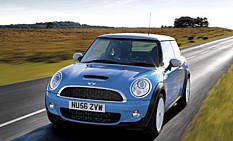Review
.
| The next generation Mini | ||||||
 |
 |
 |
 |
|||
HOW fitting that the launch of the second-generation new MINI should fall on November 18 – the very same day that Sir Alec Issigonis, creator of the original Mini in the 1950s, would have celebrated his 100th birthday.
And what a fitting birthday present this new car is, taking the style and sense of fun of Sir Alec’s original idea and developing it to meet the demands of today’s car buyers.
MINI mark II looks similar to the version launched in 2001, but every body panel is different – in fact, the only things carried over are the MINI badge and the tlc package which offers servicing (including parts and labour) over five years and 50,000 miles for £150.
The new car certainly looks bigger, even if the figures don’t always bear this out. The mark II is 64mm longer, yet 5mm narrower and 1mm shorter.
The longer body has freed up more room inside, especially in the boot and for rear-seat passengers. To be honest, both are still something of a joke, but this hasn’t hindered the car’s appeal since its launch. For the record, the boot is 10 litres bigger and there are a few more millimetres’ legroom in the back.
The interior is also all-new, though reassuringly familiar, with the large speedo dominating the dashboard and the rows of toggle switches still in place.
Also new are the engines, suspension, steering and gearbox. The engines are a joint development with PSA Peugeot Citroën, displacing 1.6 litres and offering 120bhp in the Cooper and 175 in the turbocharged Cooper S – both models being 5bhp more powerful than the cars they replace.
Only these two models will be available from launch (and both are sold out for this year), but will be joined next spring by an entry-level MINI One with a 1.4-litre 95bhp engine.
The diesel version will arrive at roughly the same time, although no details of the engine it will use are available. The Convertible model will carry over from the old shape car ‘for the foreseeable future’.
Both models cost more than before, with the Cooper rising by £600 to £12,395 and the S costing £15,995 (up £475).
However, these prices are a guide as several option packs are available, priced between £940 and £1,875 and adding items such as air conditioning.
Even so, the new models will offer company car drivers lower benefit-in-kind tax bills, thanks to the new family of engines. In the Cooper, CO2 emissions fall from 166g/km to 139 – dropping the model by five tax bands. Fuel economy is also better at 48.7mpg, compared to the old version’s 40.9mpg.
The S makes similar savings, dropping a massive nine BIK tax bands and boosting fuel economy by 8.1mpg to 40.9 combined.
Corporate business remains fairly limited and MINI doesn’t expect the current private/fleet sales ratio of 88% to 12% to change too much.
However, with MINI expecting annual sales volumes of 50,000 units in the UK, this means there will be more MINIs on fleets, simply due to the numbers involved – the previous range sold nearly 45,000 units in the UK in 2005.
However, those fleet managers who do take on the new MINI will not only be popular with their staff, they’ll also enjoy very low running costs thanks to strong residual values – CAP estimates the Cooper will retain 52% of its cost new after three years and 60,000 miles, with the Cooper S retaining 51%.
Behind the wheel
SETTLE in behind the chunky three-spoke wheel, glance over at the large central speedo and thumb the metal toggle switches – this is pure MINI. However, on the move the new model feels far removed from the previous version.
Don’t get me wrong – the new model is still an absolute barrel of laughs to drive, but in its new incarnation it’s more refined. Wind noise is well suppressed and the ride comfort is so much better that it makes the Cooper a consideration for long-distance work.
With 120bhp, the Cooper is 5bhp more powerful than before but still feels slightly strained. Once the engine is wound up, it cruises at speed quite happily, but the 1.6-litre unit does need to be revved hard to extract the performance.
Which is not the case at all with the S. Adding a turbocharger brings a welcome additional 55bhp and turns the MINI into a rocketship, making the car more efficient than the supercharged S of before (and also means there’s none of that annoying supercharger whine).
Country roads suddenly become a massive go-kart track and slow-moving vehicles can be dispatched laughably easily.
And, as the MINI retains that ‘wheel-at-each-corner’ set-up, the handling is awesome. It grips and grips and needs a lot of provocation to get it to step it out of line.
Verdict
FASTER, more spacious inside, and with better fuel economy and lower emissions – the new new MINI trumps the old new MINI in every respect. It’s a fantastic car to drive in both formats and the added comfort means longer trips can be achieved in a higher degree of comfort than before.
Fact file
| Model: | Cooper | Cooper S | ||
| Max power (bhp/rpm): | 120/6,000 | 175/5,500 | ||
| Max torque (lb-ft/rpm): | 118/6,000 | 177/1,600* | ||
| Max speed (mph): | 126 | 140 | ||
| 0-62mph (secs): | 9.1 | 7.1 | ||
| Fuel consumption (mpg): | 48.7 | 40.9 | ||
| CO2 emissions (g/km): | 139 | 164 | ||
| On sale: | Nov 18 | |||
| Prices (OTR): | £12,995 | £15,995 | ||
* Overboost offers 192lb-ft from 1,700rpm
















